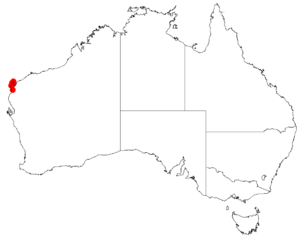Acacia alexandri facts for kids
Quick facts for kids Acacia alexandri |
|
|---|---|
| Conservation status | |
| Scientific classification | |
| Genus: |
Acacia
|
| Species: |
alexandri
|
 |
|
| Occurrence data from AVH | |
Acacia alexandri is a type of shrub that belongs to the Acacia plant family. It is found naturally in the northwestern part of Australia.
About This Plant
This shrub is often described as open and wispy. It usually grows to be about 1.5 to 3 meters (5 to 10 feet) tall. Its thin branches have small, sharp parts called stipules, which are like tiny spines. These are about 3 to 4 millimeters long, but you usually don't see them on older plants.
The plant has long, thin, green leaves, also known as phyllodes. These leaves are about 6 to 13 centimeters (2.4 to 5.1 inches) long and 2.5 to 6 millimeters (0.1 to 0.2 inches) wide. Each leaf has one clear vein running through it. Acacia alexandri blooms from August to September, producing creamy white flowers.
How It Was Named
The plant was first officially described in 1992 by a scientist named Bruce Maslin. He wrote about it in a science journal called Nuytsia. For a short time, it was also known by another name, Racosperma alexandri, given by Leslie Pedley in 2003.
Where It Lives
Acacia alexandri grows in a small area in the Gascoyne region of Western Australia. You can find it around Cape Range. It prefers rocky hillsides made of limestone. This plant grows in areas with many small trees and bushes, often in pink, rocky soil.


